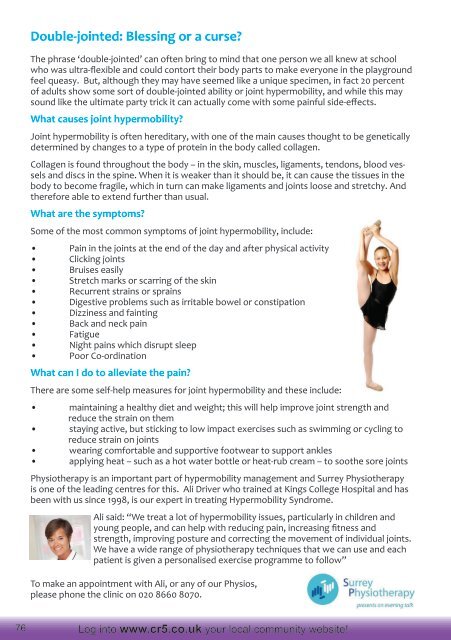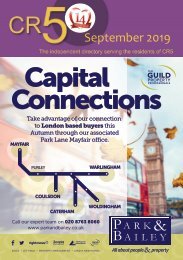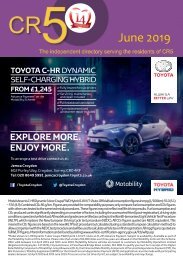CR5 Issue 146 July 2017
A local community magazine containing local business advertising, interesting reads, What's On, and puzzles
A local community magazine containing local business advertising, interesting reads, What's On, and puzzles
You also want an ePaper? Increase the reach of your titles
YUMPU automatically turns print PDFs into web optimized ePapers that Google loves.
Double-jointed: Blessing or a curse?<br />
The phrase ‘double-jointed’ can often bring to mind that one person we all knew at school<br />
who was ultra-flexible and could contort their body parts to make everyone in the playground<br />
feel queasy. But, although they may have seemed like a unique specimen, in fact 20 percent<br />
of adults show some sort of double-jointed ability or joint hypermobility, and while this may<br />
sound like the ultimate party trick it can actually come with some painful side-effects.<br />
What causes joint hypermobility?<br />
Joint hypermobility is often hereditary, with one of the main causes thought to be genetically<br />
determined by changes to a type of protein in the body called collagen.<br />
Collagen is found throughout the body – in the skin, muscles, ligaments, tendons, blood vessels<br />
and discs in the spine. When it is weaker than it should be, it can cause the tissues in the<br />
body to become fragile, which in turn can make ligaments and joints loose and stretchy. And<br />
therefore able to extend further than usual.<br />
What are the symptoms?<br />
Some of the most common symptoms of joint hypermobility, include:<br />
• Pain in the joints at the end of the day and after physical activity<br />
• Clicking joints<br />
• Bruises easily<br />
• Stretch marks or scarring of the skin<br />
• Recurrent strains or sprains<br />
• Digestive problems such as irritable bowel or constipation<br />
• Dizziness and fainting<br />
• Back and neck pain<br />
• Fatigue<br />
• Night pains which disrupt sleep<br />
• Poor Co-ordination<br />
What can I do to alleviate the pain?<br />
There are some self-help measures for joint hypermobility and these include:<br />
• maintaining a healthy diet and weight; this will help improve joint strength and<br />
reduce the strain on them<br />
• staying active, but sticking to low impact exercises such as swimming or cycling to<br />
reduce strain on joints<br />
• wearing comfortable and supportive footwear to support ankles<br />
• applying heat – such as a hot water bottle or heat-rub cream – to soothe sore joints<br />
Physiotherapy is an important part of hypermobility management and Surrey Physiotherapy<br />
is one of the leading centres for this. Ali Driver who trained at Kings College Hospital and has<br />
been with us since 1998, is our expert in treating Hypermobility Syndrome.<br />
Ali said: “We treat a lot of hypermobility issues, particularly in children and<br />
young people, and can help with reducing pain, increasing fitness and<br />
strength, improving posture and correcting the movement of individual joints.<br />
We have a wide range of physiotherapy techniques that we can use and each<br />
patient is given a personalised exercise programme to follow”<br />
To make an appointment with Ali, or any of our Physios,<br />
please phone the clinic on 020 8660 8070.<br />
76 Log into www.cr5.co.uk your local community website!

















